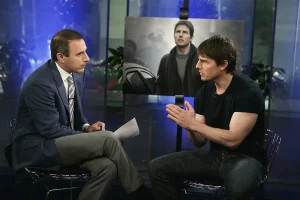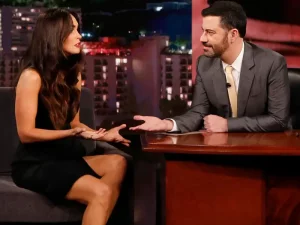Introduction
Interviewing celebrities and experts is an art that requires a blend of preparation, creativity, and skill. Whether you’re conducting the interview for a podcast, magazine, or social media, standing out from the crowd is key to making a lasting impression. This article explores 10 creative ways to interview celebrities and experts that will not only engage your audience but also bring out the best in your guests.
The Rise of Creative Interviews

Creative interviews have become more popular in recent years. Traditional interviews, where people simply ask questions and get answers, are no longer enough to capture people’s attention. With the rise of social media and digital platforms, audiences are now looking for more fun, engaging, and interactive ways to connect with celebrities and experts. Interview Celebrities Experts changing how interviews are done, focusing more on creativity and excitement.
The Role of Creative Interviews
Creative interviews have an important role in modern media. They help celebrities and experts show their true selves and connect with their audience on a deeper level. These interviews move beyond the usual questions, allowing people to see different sides of famous individuals. The main role of creative interviews is to create a more enjoyable, authentic experience for both the interviewee and the audience, making the conversation feel natural and memorable.
10 Creative Ways To Interview Celebrities

1. Start with a Personal Touch: Build a Connection
One of the most effective ways to interview celebrities and experts is to begin by establishing a personal connection. Start with a warm greeting, ask about their day or how they’re feeling, and let them relax before diving into the serious questions. Celebrities, in particular, are used to scripted questions, so showing a human side and acknowledging their personality can help set the tone for a more open conversation.
Example:
Instead of immediately asking about their latest project, you might start by asking about their hobbies, a recent vacation, or a funny story from their career. This makes the interview feel more natural and less like a formal Q&A.
2. Use Open-Ended Questions to Encourage Storytelling
To elicit more than just yes or no answers, use open-ended questions. Instead of asking, “Did you enjoy working on your latest film?” you could ask, “What was the most surprising part of working on your latest film?” Open-ended questions allow guests to share personal anecdotes and deeper insights, leading to a more engaging and authentic interview.
Example:
- “What challenges did you face during the production?”
- “How did the role change your perspective on your craft?”
3. Incorporate Interactive Activities
Taking a creative approach by incorporating interactive activities into the interview can provide a unique twist. For example, you could ask your guest to take part in a quick game or challenge that aligns with their expertise or profession. This not only adds an element of fun but also helps the audience connect with the guest on a more personal level.
Example:
For an expert on nutrition, you could have them walk through preparing a healthy snack on camera or provide a quick cooking demo. This keeps the conversation lively while still showcasing their knowledge.
4. Ask “What If” Questions to Spark Creativity
“What If” questions encourage guests to think outside the box and share their wildest ideas. These types of questions can lead to unexpected answers and uncover fascinating insights into the minds of your guests, especially celebrities who may not get asked these types of questions often.
Example:
- “What if you could star in any genre of film, regardless of your previous roles?”
- “What if you could meet any historical figure? What would you ask them?”
5. Leverage Visuals to Enhance the Experience
Incorporating visuals can make the interview much more dynamic and engaging. For example, you could show clips of their past work or images related to their area of expertise during the interview. This can serve as a conversation starter and add depth to the content, allowing the audience to visualize the guest’s journey.
Example:
For a musician, you could share their most iconic album covers or music videos, leading to a conversation about the creative process behind each piece.
6. Ask About Challenges and Failures
While discussing success is important, asking celebrities and experts about their challenges and failures can lead to more inspiring conversations. Everyone loves a success story, but understanding the setbacks they’ve overcome often humanizes the guest and creates a deeper connection with the audience.
Example:
- “Can you share a time when you faced a major setback, and how did you overcome it?”
- “What was a moment in your career when you thought of quitting, and what made you push through?”
7. Create a Rapid-Fire Round for Fun
A quick-fire round of light-hearted questions is always a fun way to keep things fresh and engaging. These can be quirky, rapid questions that give insights into the guest’s personality without the pressure of a formal answer. It keeps the energy up and gives your audience a more relaxed version of the guest.
Example:
- “Favorite vacation spot?”
- “What’s your guilty pleasure song?”
- “Coffee or tea?”
8. Use Props to Spark Conversations
Bringing props related to the guest’s career or passions can serve as a great conversation starter. These props can include books, awards, or memorabilia that highlight key moments in their career. The item can also serve as a jumping-off point for discussing specific aspects of their life or work.
Example:
If interviewing an actor, you could bring their most famous film poster or a memorabilia item from a recent project and ask them to share behind-the-scenes stories.
9. Incorporate the Audience’s Questions
A great way to make your interview feel more inclusive is to bring in questions from your audience. Whether it’s from social media or live interaction, allowing the audience to participate in the interview brings a fresh perspective and allows fans to directly engage with the celebrity or expert.
Example:
You could use a live Q&A format where you answer audience questions, giving them the chance to ask about things they’re genuinely curious about.
10. End with Thought-Provoking Questions
Wrap up the interview with thought-provoking, reflective questions that leave the audience thinking about the conversation long after it’s over. These questions can challenge the celebrity or expert to reflect on their journey, career, or personal beliefs, offering a deeper layer to the interview.
Example:
- “What legacy do you hope to leave in your field?”
- “If you could change one thing about your journey, what would it be?”
New Opportunities for Interviewees

Creative interviews also offer new opportunities for interviewees. Many celebrities and experts appreciate the chance to step out of the typical interview format and show a more playful side.
Whether it’s participating in a fun game or sharing personal stories, these creative formats allow them to connect with their audience in ways that traditional interviews don’t. Interview Celebrities Experts help build their personal brand, increase their visibility, and even make them more relatable to their fans.
Challenges of Creative Interviews

While creative interviews are exciting, they also come with some challenges. One challenge is making sure the conversation stays respectful and professional, even when the format is unusual. Some interviewees may feel uncomfortable with certain methods, especially if they are not used to them.
Creative interviews also take more time and effort to plan, as they often require special locations, props, or extra work with the audience. This can make them harder and more expensive to produce.
The Future of Creative Interviews

The future of creative interviews looks bright. As audiences continue to seek fresh content, we can expect to see even more interactive and fun formats. New technologies, such as virtual and augmented reality, may offer exciting ways to take interviews to the next level.
With digital platforms growing, celebrities and experts will have more opportunities to connect with their fans in creative ways, building stronger relationships and keeping their audiences engaged.
Analysis Table: Comparison of Creative Interview Techniques
| Technique | Purpose | Benefits | Drawbacks |
|---|---|---|---|
| Start with a Personal Touch | Build rapport | Creates a comfortable atmosphere | May not be suitable for all interview types |
| Use Open-Ended Questions | Encourage deeper conversation | Uncovers insights and stories | May lead to overly long responses |
| Incorporate Interactive Activities | Engage the guest and audience | Fun and memorable interaction | Can feel forced or awkward |
| Ask “What If” Questions | Stimulate creative thinking | Reveals unique perspectives | May not always produce relevant answers |
| Leverage Visuals | Enhance engagement through visuals | Provides a richer context for the interview | May require technical setup |
| Discuss Challenges and Failures | Create a relatable, human connection | Inspires audience and adds depth | May make guests uncomfortable |
| Rapid-Fire Round | Keep the interview lively and spontaneous | Adds energy and lightens the mood | Might be perceived as too casual |
| Use Props | Add personal touch and conversation starters | Makes the conversation more visual and engaging | Risk of distraction or irrelevant items |
| Incorporate Audience Questions | Make the interview more interactive | Engages fans and adds variety | May lead to off-topic or awkward moments |
| End with Thought-Provoking Questions | Leave the audience with something to ponder | Encourages deeper reflection | Can feel out of place if not framed well |
Comparative Table: Traditional vs. Creative Interviews
| Aspect | Traditional Interviews | Creative Interviews |
|---|---|---|
| Question Style | Mostly formal and scripted | Open-ended, fun, and personalized |
| Guest Engagement | Limited interaction with the audience | High engagement, often includes audience Q&A |
| Format | Structured, one-on-one discussion | Dynamic, can include games or activities |
| Tone | Professional and serious | Relaxed and engaging |
| Audience Appeal | Informative but often predictable | Entertaining and thought-provoking |











